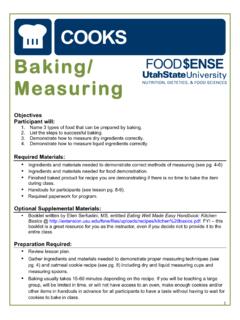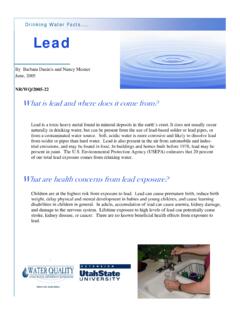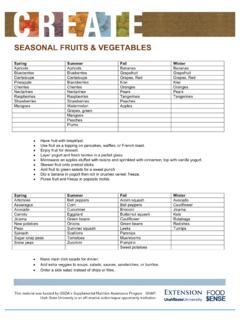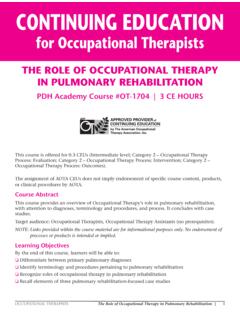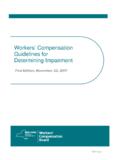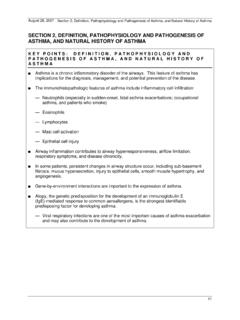Transcription of Mindfulness for Chronic Pain Management - USU
1 June 2019 - FC/Health/2019-01pr Mindfulness for Chronic Pain Management Maren Wright Voss, ScD; Kandice Atisme, MPH; Ashley Yaugher, PhD; and Sandra Sulzer, PhD What is Mindfulness ? Mindfulness has a rich history originating from a blend of modern psychology and ancient meditation practices. In healthcare, Mindfulness has two essential components: Focused attention Focused attention includes noticing and thinking about an object or sensation (such as breathing, warmth, a light, movement, something being held, a taste or smell). Open monitoring Open monitoring is the act of noticing thoughts and mental experiences while at the same time reflecting on the process of thinking (nonjudgmental observation).2,3 Chronic pain is pain that lasts longer or is stronger than what is considered to be normal within the healing period.
2 Chronic pain can be the result of modulation (see Figure 1). In other words, pain signals can be altered and changed in the spinal cord making them stronger than This means the experience of pain can be changed (modulated), if we find the right techniques. Why Mindfulness ? Mindfulness is an evidence-based approach to dealing with Chronic pain that has been tested and proven effective for over 35 Mindfulness reduces reports of pain as well as use of pain Mindfulness -based approaches to reducing stress can increase coping ability, r educe pain, and lessen psychological distress ( , depression, worry, sadness, or anxiety).8,9 Mindfulness has long-lasting effects: the changes in attention and thinking can continue to control pain even after it is ,10 Mindfulness can be used anywhere and at any time to reduce pain.
3 Addiction to Pain Medication Opioids have two effects in the brain, 1) an analgesic (pain-reducing) effect, and 2) a learned association of feeling relief. As the connection between medication and relief strengthens over time, lower levels of pain start to trigger the need for pain relief. This may result in early, inappropriate use of pain Treatment of Chronic pain with opioids can create the experience of more pain (hyperalgesia) because of the changes in pain perception. The increase in pain can lead to increased stress. The pain and stress can start an addictive process of seeking more medication. The result can be a feeling of needing more medicine, even though the medicine isn t helping as much as it did in the In other words, over time, individuals may feel more pain despite increasing their medication dosage, resulting in substance misuse.
4 Mindfulness is paying attention in a particular way: on purpose, in the present, and nonjudgmentally. 4 (Kabat Zinn, 2009) How Mindfulness Works Mindfulness targets sections of the brain that can be affected by stress, pain, and Mindfulness can restore the ability to mentally manage pain, emotion, and Instead of avoiding pain, Mindfulness increases the ability to bear the unpleasant feeling without distress. Mindfulness is a type of mental training to develop skills in: Self-regulation regulating pain, emotions, and actions without outside help Attentional re-orienting not allowing a distracting thought or feeling to linger, or shifting attention away from distractions, back to the point of focus Metacognition being aware of your thoughts Reappraisal looking at something a second time to determine its meaning Inhibitory control changing habitual reactions to things/situations Figure 1.
5 Anatomy of Pain There are four steps in the pain process: 1. Sensory neurons respond to harmful stimuli ( , trauma, inflammation , infection) sending the pain signal to the brain. 2. The signal of pain moves from the initial site of injury, through the spinal cord, to the brain stem. 3. The brain stem activates the brain centers where sensations, reactions, and emotional responses to pain are created. 4. Pain sensations can change or be blocked in the spinal cord. This can result in more or less pain than would be normal for the injury. This process is called Mindfulness changes the way the brain experiences rewards. It restores positive feelings that have become harder to achieve over Through this process, comfort and contentedness can be restored.
6 Getting the Most Out of Mindfulness13 Bring a beginner s mind. Allow yourself to experience each moment as fresh and new without any expectations of what it could become. Nurture nonjudgment. It takes practice to slow things down and let distractions pass you by without passing judgement on likes/dislikes. Cultivate acceptance by actively recognizing that things are the way they are. Focus on non-striving by experiencing each moment of life without trying to make anything happen. Let go. Allow things to be what they are, without dwelling, and recognize that mindfully letting go is your doorway to freedom. Practice gratitude. Focus on the positive, don t allow yourself to take the amazing things happening in your life each day for granted.
7 Some Examples of Every-Day Mindfulness Activities Use your five senses to cultivate Mindfulness in your daily life (sight, sound, taste, touch, and smell). What How Mindful stretching or relaxation in the morning Before getting out of bed in the morning, notice your breathing and take a few deep breaths or do some light stretching while focusing on the present moment and mentally accept the experiences this day will bring. Mindfulness during daily grooming During daily grooming tasks (teeth brushing, bathing, hand washing, etc.) notice your five senses ( , smells, sights, sounds, tastes, sensations from touch) in the moment and be present in your experience to minimize a wandering mind. Mindful walks Be mindful by noticing what is going on around you and focus on your five senses ( , smells, sights, sounds, tastes, sensations from your feet touching the ground) or focus on finding things in your environment for each color on the color wheel ( , red, orange, yellow, green, blue, and purple) to stay present Mindful eating Focus on each aspect of eating through your five senses ( , smells, sights, sounds, tastes, sensations from touch) with emphasis on taste in the moment and be present in your experience to minimize a wandering mind Mindfulness during repetitive tasks During repetitive tasks ( , dish washing, waiting in lines, laundry) notice your five senses ( , smells, sights, sounds, tastes, sensations from touch)
8 In the moment and be present to experience Mindfulness . Mindful meditation, pondering, or prayer at morning or night Experience your thoughts or prayers in a nonjudgmental and accepting way, notice any judgements you may have and let them go, or replace negative thinking with a focus on things you are grateful for or keep a gratitude journal. Getting Started in Mindfulness Meditation13 Set aside a time and place to meditate. Sit comfortably in a chair or on the floor with your back straight. Close your eyes, or loosely focus your gaze on an object. Breathe slowly, deeply, and gently. Keep your mind focused inward or on an object. If your mind wanders, gently guide it back to center. Breathe peace and quiet into your heart and mind.
9 Be kind to yourself and let go of judgments or negative thoughts you may be having. Start small, without expectations or judgment of how long or how often to practice. Wherever you go, there you are. (Kabat Zinn, 2009) Mindfulness Resources** Websites: 1. American Mindfulness Research Association (AMRA): 2. Self-Compassion (Dr. Kristin Neff): 3. UC San Diego Health (Center for Mindfulness , Videos About Stress and Mindfulness ): 4. UC San Diego Health (Center for Mindfulness , Guided Audio Files to Practice MBSR): Books: 1. The Mindfulness Solution to Pain: Step-by-Step Techniques for Chronic Pain Management by Jackie Gardner-Nix 2. Mindfulness for Beginners by Jon Kabat-Zinn 3. Wherever you go, There you are by Jon Kabat-Zinn 4.
10 Mindfulness : An Eight-Week Plan for Finding Peace in a Frantic World by Danny Penman and J. Mark G. Williams Disclaimer *Always consult a doctor when considering treatment or Management of a medical condition. **Please note that all of the resources provided are for educational purposes and USU does not specifically endorse their services. Mindfulness resources are intended to provide information, not to treat Chronic pain or other mental health concerns. USU does not control the websites or books referenced above. Utah State University is committed to providing an environment free from harassment and other forms of illegal discrimination based on race, color, religion, sex, national origin, age (40 and older), disability, and veteran s status.


